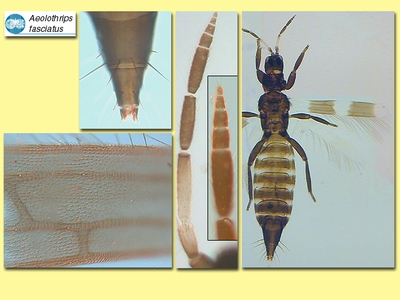Figures
Fig. 1 Antenna, head, throax, abdomen and wings
Fig. 2 Abdomen (male)
Species
Aeolothrips fasciatus Linneaus
Biology
Adults and larvae feed in various flowers, but pupae occur on the ground. Larvae and adults feed on flower tissues and on the larvae of other thrips species.
Distribution
Widespread in Europe and North America; established in Tasmania (possibly Victoria) and New Zealand.
Recognition
A large dark thrips with broad, banded forewings and antennal segment III slender and yellow with the extreme apex dark. Antennae 9-segmented, segments III & IV with linear sensorium in apical third; segments V-IX forming a single unit. Maxillary palps with second segment not subdivided. Forewing with two dark transverse bands, apex of wing pale. Body with no long setae except at abdominal apex. Mesonotum with one pair of setae medially. Metanotum reticulate, with no markings inside the reticles. Sternites III-VI with setae only at posterior margin. Male with a pair of distinctive claspers on tergite IX; at the base of each of these is a seta that is longer than the clasper.
Related species
About 100 species are known in this genus, almost all from the northern hemisphere temperate zone. The females of one of these, A. intermedius Bagnall, are sometimes misidentified as A. fasciatus, although the males can be distinguished readily because the seta at the base of each clasper is shorter than the clasper (Mound & Gillespie, 1997).



